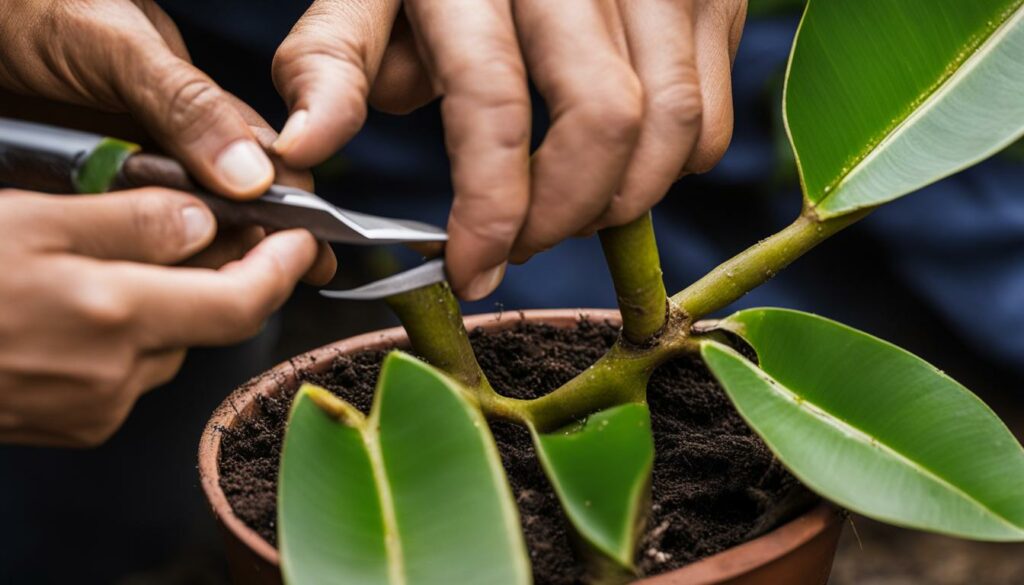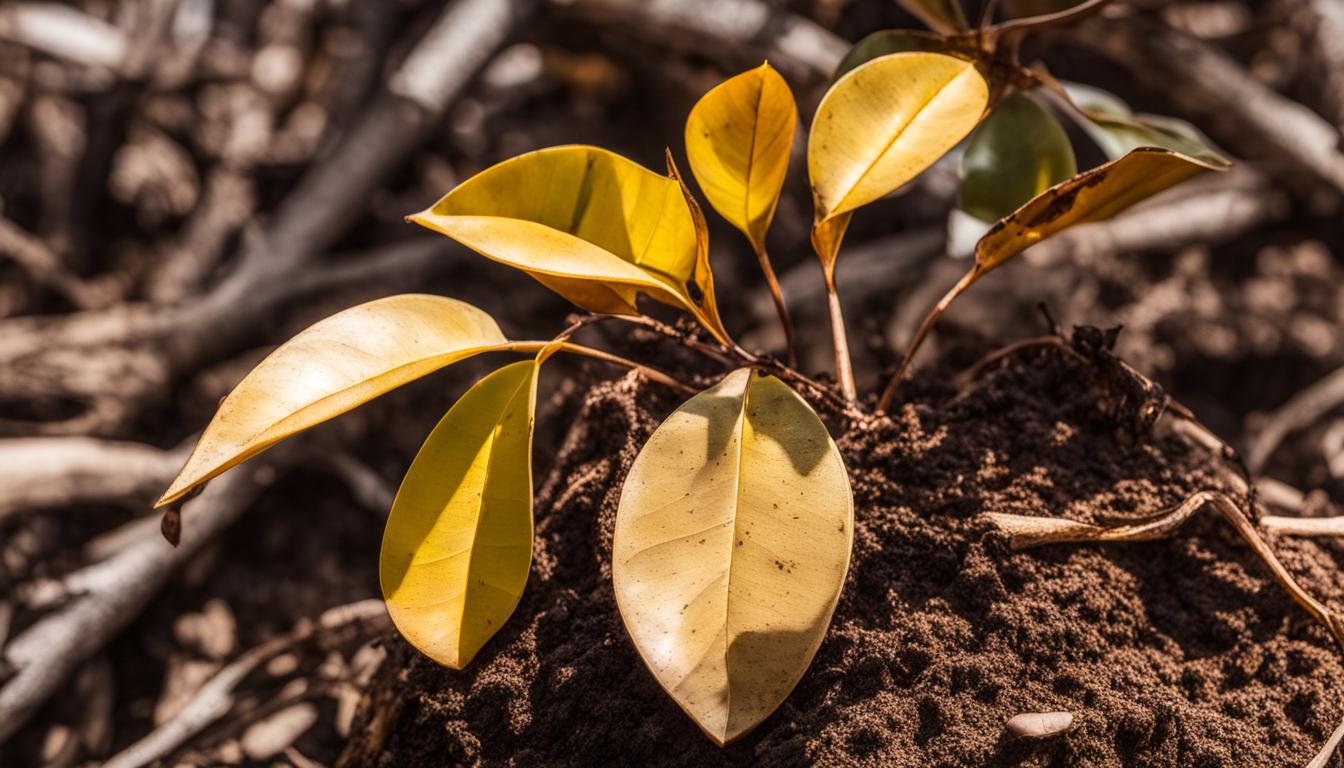Welcome to our comprehensive guide on how to propagate Tineke Rubber Tree, a popular indoor plant with stunning variegated foliage. Whether you’re a plant enthusiast looking to expand your collection or a beginner eager to try your hand at plant propagation, this step-by-step guide will provide you with all the information you need to successfully propagate Tineke Rubber Tree.
Plant propagation techniques are an exciting way to grow new plants from existing ones, and Tineke Rubber Tree is no exception. In this guide, we will explore two methods: air layering and cuttings. Both methods have proven to be successful in propagating indoor plants, and we will walk you through the process in detail to ensure your success.
From choosing the right tools and supplies to providing the optimal conditions for growth, we will cover everything you need to know to propagate Tineke Rubber Tree like a pro. Whether you prefer nursery propagation methods or want to try your hand at home, this guide has got you covered.
Ready to dive in? Let’s get started on this exciting journey of successful rubber tree propagation!
Overview of the Tineke Rubber Tree
The Tineke Rubber Tree, also known as Ficus Elastica Tineke, is a captivating houseplant that boasts remarkable variegated foliage. Belonging to the Moraceae family, this plant is native to Asia. With its unique leaf coloration and robust growth, it has become a popular choice for both indoor and outdoor cultivation. When properly cared for, the Tineke Rubber Tree can add a touch of natural beauty to any space.
This stunning plant thrives in well-drained soil and prefers a humidity level of around 40-50%. It is important to provide the Tineke Rubber Tree with temperatures between 60F-70F and partial sunlight to ensure optimal growth. However, it is essential to avoid exposing the plant to intense sunlight, as it can lead to scorching of the foliage. Like many plants, the Tineke Rubber Tree is susceptible to pests such as mites, aphids, and scale, as well as diseases like root rot. Taking precautions and providing the right care can help keep these issues at bay.
Overall, the Tineke Rubber Tree is a visually striking plant that brings elegance and freshness to any indoor or outdoor space. Its eye-catching variegated foliage and easy care requirements make it a desirable choice for plant enthusiasts.
Proper Care for Tineke Rubber Tree
Proper care is essential for the health and thriving of your Tineke Rubber Tree. Follow these guidelines to ensure optimal growth and vitality:
Watering:
It is important to maintain the right watering schedule for your Tineke Rubber Tree. Allow the top few inches of soil to dry out before watering again. Overwatering can lead to root rot, while underwatering can cause the leaves to droop and curl. A good rule of thumb is to water the plant once every one or two weeks, depending on the humidity levels and the overall moisture retention of the soil.
Light Conditions:
Tineke Rubber Trees thrive in bright, indirect light conditions. Position your plant near a window where it can receive bright, filtered sunlight. Avoid placing it in direct sunlight as it can scorch the leaves. If you notice the leaves losing variegation or becoming pale, it may be an indication that the plant is not receiving enough light.
Humidity Requirements:
Tineke Rubber Trees prefer a humid environment. Maintain humidity levels of at least 40-50% by placing the plant in a draft-free area or using a humidifier. This will help prevent the leaves from drying out and promote healthy growth. Misting the leaves occasionally can also provide a boost of humidity.
Pruning for Shape and Size:
Regular pruning is important to maintain the desired shape and size of your Tineke Rubber Tree. Prune during the summer and spring seasons to encourage new growth and remove any dead or damaged leaves. Use clean pruning shears to make clean cuts, and consider wearing gloves to protect your hands from the sap, which may cause skin irritation.
Potting Medium:
Choose a well-draining potting mix for your Tineke Rubber Tree. A mixture of cacti soil, orchid soil, perlite, and charcoal works well. This type of medium provides proper aeration and drainage, preventing waterlogged roots. Ensure the pot has drainage holes to avoid water accumulation.
Fertilization:
Feed your Tineke Rubber Tree with a balanced liquid fertilizer once a month during the active growth season, typically from spring to summer. Follow the instructions on the fertilizer packaging for the correct dilution and application rate. Avoid over-fertilizing, as it can lead to salt buildup in the soil.
Repotting:
Repotting is necessary when the roots become overcrowded or when the plant outgrows its current pot. Repot your Tineke Rubber Tree every one to two years using a slightly larger pot with fresh potting mix. This will provide the plant with additional space for root growth and ensure continued healthy development.
By following these care guidelines, you can ensure the well-being and beauty of your Tineke Rubber Tree. With proper watering, suitable light conditions, adequate humidity, regular pruning, and appropriate potting and fertilization, your plant will thrive and bring joy to your indoor space.
| Aspect | Requirements |
|---|---|
| Watering | Allow the top few inches of soil to dry out before watering. Water once every one or two weeks. |
| Light Conditions | Bright, indirect light. Avoid direct sunlight. |
| Humidity | Maintain humidity levels of 40-50%. Use a humidifier or mist the leaves. |
| Pruning | Regular pruning in summer and spring to maintain shape and remove dead or damaged leaves. |
| Potting Medium | Well-draining mix of cacti soil, orchid soil, perlite, and charcoal. |
| Fertilization | Monthly balanced liquid fertilizer during active growth season. |
| Repotting | Every one to two years in a slightly larger pot with fresh potting mix. |
Propagating Tineke Rubber Tree through Air Layering
Air layering is an effective method for propagating Tineke Rubber Trees and can be done with a few simple tools and supplies. To begin, you will need gardening shears, a clear plastic bag, a toothpick, twist ties, and long-fibered sphagnum moss.
Start by selecting a healthy stem on the Tineke Rubber Tree and make an upward diagonal cut. This cut should be deep enough to reach the inner layer of the stem. Apply rooting hormone to the cut area using a toothpick to ensure proper application.
Next, take moistened sphagnum moss and wrap it around the cut portion of the stem. The moss should be kept consistently moist throughout the process. Cover the moss-wrapped area with plastic wrap, securing it with twist ties to create a greenhouse-like environment. This will provide the necessary moisture and humidity for root development.
Over the next few months, new roots will begin to grow from the moss-wrapped section of the stem. Once a sufficient root system has developed, remove the plastic wrap and make a clean cut below the new root growth. Transplant the newly propagated plant into fresh soil, ensuring that the roots are well-covered.
By following these steps, you can successfully propagate your Tineke Rubber Tree through air layering. This method is a reliable way to expand your plant collection and enjoy the beauty of these variegated houseplants.
Propagating Tineke Rubber Tree through Cuttings
To propagate a Tineke Rubber Tree through cuttings, you’ll need a few essential tools and supplies. Sharp pruning shears are necessary for making clean cuts, while wearing protective gloves is recommended to avoid skin irritation from the plant’s sap. You will also need perlite, soilless potting mix, a small plastic pot, rooting hormone, and a large zip-top plastic bag to create a greenhouse-like environment.
Start by selecting a healthy stem with at least four leaf nodes. Using sharp pruning shears, make a swift and straight cut just above and below a node. Next, remove the bottom leaves from the cutting, leaving only a few leaves at the top. This will help the cutting focus its energy on root development.
Once you have prepared the cutting, dip the cut end in rooting hormone to encourage root growth. Plant the cutting in a mix of soilless potting mix and perlite, ensuring good drainage. Place the potted cutting inside a large zip-top plastic bag, creating a sealed environment that will help retain moisture. Keep the cutting in a warm location with indirect sunlight and monitor its progress over the next four to five weeks for root development.

Table: Tools and Supplies for Propagating Tineke Rubber Tree
| Tools | Supplies |
|---|---|
| Sharp pruning shears | Perlite |
| Protective gloves | Soilless potting mix |
| Small plastic pot | Rooting hormone |
| Large zip-top plastic bag |
With proper care and attention, your Tineke Rubber Tree cutting should develop strong roots and eventually become a new plant. Once roots have formed, you can successfully transplant the cutting into its own pot and continue to nurture its growth.
Precautions and Tips for Successful Propagation
When propagating the Tineke Rubber Tree, it is important to take certain precautions and follow specific tips to ensure successful results. Here are some key factors to consider:
Rubber Tree Toxicity
The Tineke Rubber Tree is known to be toxic to humans and pets if ingested. To avoid any potential harm, it is crucial to handle the plant with care and take necessary precautions. Wear gloves when pruning and propagating to protect your skin from potential irritation caused by the plant’s sap.
Timing and Season
Timing plays a significant role in the success of propagating Tineke Rubber Trees. It is recommended to carry out propagation during the early spring to late summer when the weather is warm and conducive to root development. This period allows the plant to thrive and establish new roots more effectively.
Importance of Healthy Mother Plant
The mother plant from which you take cuttings or perform air layering should be healthy and free from any signs of distress or pest infestation. Starting with a strong and vigorous mother plant increases the chances of successful propagation, as it provides the best genetic material for new growth.

By following these precautions and tips, you can increase your chances of successfully propagating the Tineke Rubber Tree. Remember to handle the plant’s sap with care, choose the right timing and season, and start with a healthy mother plant to ensure optimal results.
Conclusion
To successfully propagate your Tineke Rubber Tree, follow the step-by-step guide for either air layering or cuttings. These propagation methods allow you to expand your collection of these stunning houseplants and enjoy their variegated foliage.
Remember to handle the sap with care, as it can cause skin irritation. Wear protective gloves when pruning and propagating to avoid any discomfort.
Choose a healthy mother plant and propagate during the optimal time of year, which is from early spring to late summer. This will increase your chances of success and ensure that the new plants thrive.
With proper care and attention, you can successfully propagate your Tineke Rubber Tree. Enjoy the process and watch as your collection grows!
FAQ
How often should I water my Tineke Rubber Tree?
Water your Tineke Rubber Tree once every one or two weeks, allowing the top few inches of soil to dry out before watering again.
How much sunlight does a Tineke Rubber Tree need?
Provide your Tineke Rubber Tree with bright indirect sunlight to maintain variegation and leaf coloration, while avoiding intense sunlight that can scorch the foliage.
How do I increase humidity for my Tineke Rubber Tree?
Maintain humidity levels of at least 40-50% by placing the plant in a draft-free area or using a humidifier.
When should I prune my Tineke Rubber Tree?
Prune your Tineke Rubber Tree in summer and spring to maintain its shape and size.
How often should I fertilize my Tineke Rubber Tree?
Fertilize your Tineke Rubber Tree monthly during the active growth season.
How do I propagate a Tineke Rubber Tree through air layering?
To propagate through air layering, make an upward diagonal cut on a healthy stem, apply rooting hormone, wrap moist sphagnum moss around the cut, cover it with plastic wrap, and wait for new roots to grow.
How do I propagate a Tineke Rubber Tree through cuttings?
To propagate through cuttings, take a 6-inch stem with at least four leaf nodes, remove the bottom leaves, apply rooting hormone, plant it in a mix of gardening soil and perlite, and create a greenhouse-like environment using a plastic bag.
Is the Tineke Rubber Tree toxic to humans and pets?
Yes, the Tineke Rubber Tree is toxic to humans and pets. Handle the plant with care and avoid ingestion.
When is the best time to propagate a Tineke Rubber Tree?
It is best to propagate a Tineke Rubber Tree during the early spring to late summer when the weather is warm.



